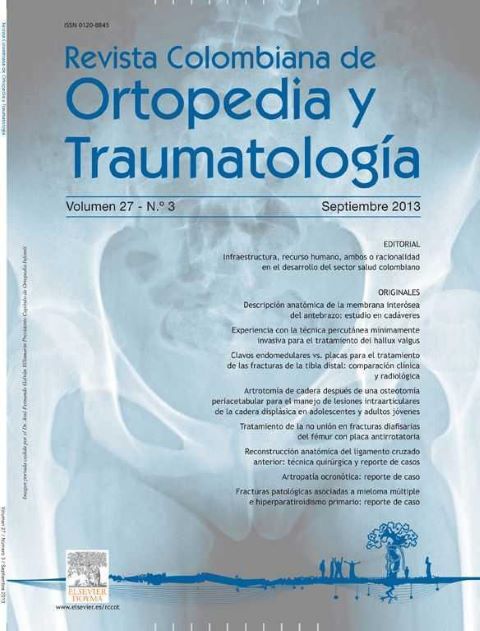Clavos endomedulares vs. placas para el tratamiento de las fracturas de la tibia distal: comparación clínica y radiológica
DOI:
https://doi.org/10.1016/S0120-8845(13)70011-7Palabras clave:
fracturas de la tibia, fijación intramedular de las fracturas, placas óseas, fijación interna de las fracturas, nivel de evidencia: IVResumen
Introducción: El manejo quirúrgico de las fracturas distales de la tibia es controvertido; los resultados de los estudios no muestran superioridad de una técnica sobre la otra. Los objetivos de esta investigación fueron comparar los resultados clínicos, radiológicos y funcionales de los pacientes manejados con clavos endomedulares y placas.
Materiales y métodos: Se realizó un estudio cuasi experimental en 25 pacientes con fracturas de la tibia distal ocurridas entre abril de 2009 y marzo de 2011. Se documentó la presencia de consolidación clínica y radiológica de las fracturas, y se aplicó la escala funcional IOWA. Además, se tuvo en cuenta la duración de las cirugías, la estancia hospitalaria y el tiempo entre el ingreso y la cirugía definitiva.
Resultados: Todas las fracturas consolidaron al final del seguimiento. La consolidación clínica y radiológica no mostró diferencias entre los 2 grupos de tratamiento. Los resultados funcionales fueron excelentes en ambos grupos. Aunque no fueron estadísticamente significativos, la duración de las cirugías, la estancia hospitalaria y el tiempo transcurrido entre el ingreso hospitalario y la fijación definitiva fueron menores en los pacientes tratados con clavos endomedulares.
Discusión: La consolidación clínica y radiológica y los resultados funcionales fueron similares en los 2 grupos. No se puede concluir la superioridad de un método sobre otro, pero se sugiere que la elección se haga con base en la experiencia y preferencia del cirujano.
Descargas
Referencias bibliográficas
Bedi A, Le TT, Karunakar MA. Surgical treatment of nonarticular distal tibia fractures. J Am Acad Orthop Surg. 2006;14:406-16. https://doi.org/10.5435/00124635-200607000-00003
Fisher WD, Hamblen DL. Problems and pitfalls of compression fixat ion of long bone fract ures: a review of result s and complications. Injury. 1978;10:99-107. https://doi.org/10.1016/S0020-1383(79)80069-8
McFerran MA, Smith SW, Boulas HJ, Schwartz HS. Complications encountered in the treatment of pilon fractures. J Orthop Trauma.1992;6:195-200. https://doi.org/10.1097/00005131-199206000-00011
Olerud S, Karlst röm G. Tibial fract ures t reat ed by AO compression osteosynt hesis: experiences from a five year material. Acta Orthop Scand Suppl. 1972;140:1-104. https://doi.org/10.3109/ort.1972.43.suppl-140.01
Rüedi T. Fractures of the lower end of the tibia into the ankle joint: results 9 years after open reduction and internal fixation. Injury.1973;5:130-4. https://doi.org/10.1016/S0020-1383(73)80089-0
Collinge C, Sanders R, DiPasquale T. Treatment of complex tibial periarticular fractures using percutaneous techniques. Clin Orthop Relat Res. 2000:69-77.
Francois J, Vandeputte G, Verheyden F, Nelen G. Percutaneous plate fixation of fractures of the distal tibia. Acta Orthop Belg. 2004;70:148-54.
Bahari S, Lenehan B, Khan H, McElwain JP. Minimally invasive percut aneous plate fixat ion of dist al t ibia fractures. Act a Orthop Belg. 2007;73:635-40.
Hazarika S, Chakravart hy J, Cooper J. Minimally invasive locking plat e ost eosynt hesis for fract ures of t he dist al tibia-results in 20 patients. Injury. 2006;37:877-87. https://doi.org/10.1016/j.injury.2006.06.002
Collinge C, Prot zman R. Outcomes of minimally invasive plate osteosynthesis for metaphyseal distal tibia fractures. J Orthop Trauma. 2010;24:24-9. https://doi.org/10.1097/BOT.0b013e3181ac3426
Collinge C, Kuper M, Larson K, Prot zman R. Minimally invasive plat ing of high-energy met aphyseal dist al t ibia fract ures. J Orthop Trauma. 2007;21:355-61. https://doi.org/10.1097/BOT.0b013e3180ca83c7
Ehlinger M, Adam P, Bonnomet F. Minimally invasive locking screw plate fixation of non-articular proximal and distal tibia fractures. Orthop Traumatol Surg Res. 2010;96:800-9. https://doi.org/10.1016/j.otsr.2010.03.025
Gupta RK, Rohilla RK, Sangwan K, Singh V, Walia S. Locking plate fixation in distal metaphyseal tibial fractures: series of 79 patients. Int Orthop. 2010;34:1285-90. https://doi.org/10.1007/s00264-009-0880-4
Ronga M, Longo UG, Maffulli N. Minimally invasive locked plat ing of dist al t ibia fract ures is safe and effect ive. Clin Orthop Relat Res. 2010;468:975-82. https://doi.org/10.1007/s11999-009-0991-7
Hasenboehler E, Rikli D, Babst R. Locking compression plate wit h minimally invasive plate osteosynt hesis in diaphyseal and distal tibial fracture: a retrospective study of 32 patients. Injury. 2007;38:365-70. https://doi.org/10.1016/j.injury.2006.10.024
Krackhardt T, Dilger J, Flesch I, Hönt zsch D, Eingart ner C, Weise K. Fract ures of t he dist al t ibia t reated wit h closed reduction and minimally invasive plating. Arch Orthop Trauma Surg. 2005;125:87-94. https://doi.org/10.1007/s00402-004-0778-y
Redfern DJ, Syed SU, Davies SJ. Fractures of the distal tibia: minimally invasive plate osteosynthesis. Injury. 2004;35:615-20. https://doi.org/10.1016/j.injury.2003.09.005
Helfet DL, Shonnard PY, Levine D, Borrelli J Jr. Minimally invasive plate osteosynthesis of distal fractures of the tibia. Injury. 1997;28 Suppl 1:A42-7. https://doi.org/10.1016/S0020-1383(97)90114-5
Blachut PA, O'Brien PJ, Meek RN, Broekhuyse HM. Interlocking int ramedullary nailing wit h and wit hout reaming for t he treatment of closed fractures of the tibial shaft. A prospective, randomized study. J Bone Joint Surg Am. 1997;79:640-6. https://doi.org/10.2106/00004623-199705000-00002
Finkemeier CG, Schmidt AH, Kyle RF, Templeman DC, Varecka TF. A prospective, randomized study of intramedullary nails inserted with and without reaming for the treatment of open and closed fractures of the tibial shaft. J Orthop Trauma. 2000;14:187-93. https://doi.org/10.1097/00005131-200003000-00007
Keating JF, O'Brien PJ, Blachut PA, Meek RN, Broekhuyse HM. Locking intramedullary nailing with and without reaming for open fractures of the tibial shaft. A prospective, randomized study. J Bone Joint Surg Am. 1997;79:334-41. https://doi.org/10.2106/00004623-199703000-00003
Fan CY, Chiang CC, Chuang TY, Chiu FY, Chen TH. Interlocking nails for displaced metaphyseal fractures of the distal tibia. Injury. 2005;36:669-74. https://doi.org/10.1016/j.injury.2004.10.018
Nork SE, Schwart z AK, Agel J, Holt SK, Schrick JL, Winquist RA. Intramedullary nailing of distal metaphyseal tibial fractures. J Bone Joint Surg Am. 2005;87:1213-21. https://doi.org/10.2106/00004623-200506000-00005
Dogra AS, Ruiz AL, Thompson NS, Nolan PC. Dia-metaphyseal distal tibial fractures-treatment with a shortened intramedullary nail: a review of 15 cases. Injury. 2000;31:799-804. https://doi.org/10.1016/S0020-1383(00)00129-7
Tyllianakis M, Megas P, Giannikas D, Lambiris E. Interlocking intramedullary nailing in distal tibial fractures. Orthopedics. 2000;23:805-8. https://doi.org/10.3928/0147-7447-20000801-13
Mohammed A, Saravanan R, Zammit J, King R. Intramedullary t ibial nailing in dist al t hird t ibial fractures: dist al locking screws and fracture non-union. Int Orthop. 2008;32:547-9. https://doi.org/10.1007/s00264-007-0356-3
Megas P, Zouboulis P, Papadopoulos AX, Karageorgos A, Lambiris E. Distal tibial fractures and non-unions treated with shortened intramedullary nail. Int Orthop. 2003;27:348-51. https://doi.org/10.1007/s00264-003-0499-9
Obremskey WT, Medina M. Comparison of int ramedullary nailing of distal third tibial shaft fractures: before and after traumatologists. Orthopedics. 2004;27:1180-4. https://doi.org/10.3928/0147-7447-20041101-15
Russell GV Jr, Pearsall AW 4t h. Int ramedullary nailing of distal tibial fractures: a technique to prevent malalignment. Orthopedics. 2003;26:183-5. https://doi.org/10.3928/0147-7447-20030201-23
Im GI, Tae SK. Dist al met aphyseal fract ures of t ibia: a prospect ive randomized t rial of closed reduct ion and int ramedullary nail versus open reduct ion and plat e and screws fixation. J Trauma. 2005;59:1219-23. https://doi.org/10.1097/01.ta.0000188936.79798.4e
Yang SW, Tzeng HM, Chou YJ, Teng HP, Liu HH, Wong CY. Treatment of distal tibial metaphyseal fractures: Plating versus shortened intramedullary nailing. Injury. 2006;37:531-5. https://doi.org/10.1016/j.injury.2005.09.013
Hoenig M, Gao F, Kinder J, Zhang LQ, Collinge C, Merk BR. Extra-articular distal tibia fractures: a mechanical evaluation of 4 different treatment methods. J Orthop Trauma. 2010;24:30-5. https://doi.org/10.1097/BOT.0b013e3181c29bc0
Janssen KW, Biert J, van Kampen A. Treatment of distal tibial fractures: plate versus nail: a retrospective outcome analysis of matched pairs of patients. Int Orthop. 2007;31:709-14. https://doi.org/10.1007/s00264-006-0237-1
Guo JJ, Tang N, Yang HL, Tang TS. A prospective, randomised t r ial compar ing closed int r amedull ar y nailing wit h percutaneous plating in the treatment of distal metaphyseal fractures of the tibia. J Bone Joint Surg Br. 2010;92:984-8. https://doi.org/10.1302/0301-620X.92B7.22959
Zelle BA, Bhandari M, Espiritu M, Koval KJ, Zlowodzki M. Treatment of distal tibia fractures without articular involvement: a systematic review of 1125 fractures. J Orthop Trauma. 2006;20:76-9. https://doi.org/10.1097/01.bot.0000202997.45274.a1
Merchant TC, Dietz FR. Long-term follow-up after fractures of the tibial and fibular shafts. J Bone Joint Surg Am. 1989;71:599-606. https://doi.org/10.2106/00004623-198971040-00016
Descargas
Publicado
Cómo citar
Número
Sección
Licencia
Derechos de autor 2024 Revista Colombiana de ortopedia y traumatología

Esta obra está bajo una licencia Creative Commons Reconocimiento 3.0 Unported.








